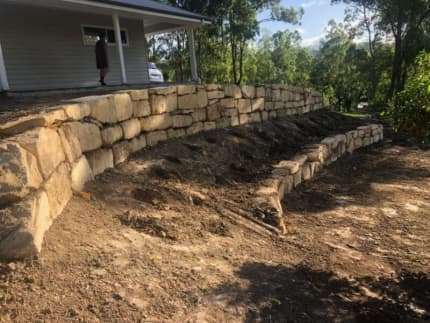When it comes to landscaping and hardscaping, boulders are a popular choice for adding natural beauty, structure, and functionality to outdoor spaces. Two common types of boulders are hammered and natural random boulders. Each type has its own distinct characteristics, benefits, and uses, making them suitable for different design styles and purposes. In this detailed guide, we’ll explore the differences between hammered and natural random boulders, helping you make an informed choice for your next project.
Understanding Boulders in Landscaping
What Are Boulders?
Boulders are large, naturally occurring stones that are often used in landscaping and construction. They come in various sizes, shapes, and textures, and are typically used to create visual interest, provide structural support, or enhance the natural look of a space. Boulders can serve multiple functions, from creating retaining walls and garden features to forming pathways and water features.
Why Use Boulders?
- Aesthetic Appeal: They add a natural, rugged look to landscapes, blending seamlessly with outdoor environments.
- Durability: They are long-lasting and withstand weather conditions, making them a practical choice for outdoor features.
- Versatility: Boulders can be used in a variety of applications, including garden beds, rock gardens, retaining walls, and more.
- Low Maintenance: Once installed, boulders require minimal maintenance compared to other landscaping materials.
Hammered Boulders
What Are Hammered Boulders?

Hammered, also known as split or chiseled, are large stones that have been intentionally altered using a hammer or chisel to achieve a specific texture. This process involves breaking or chipping the surface of the boulder to create a more refined, uniform appearance. They can be quite blocky and have 1 flat side suitable for retaining walls
Characteristics of Hammered Boulders
- Texture: Hammered feature a distinctive, rough texture with chiseled marks that give them a more sculpted appearance. The surface can vary from moderately rough to heavily textured, depending on the technique used.
- Shape and Size: While hammered can come in various sizes, they often have a more consistent shape compared to natural random boulders. The chisel marks can also influence the overall shape, making them appear more uniform.
- Colour: The colour of hammered can vary based on the type of stone used. The hammering process may also affect how light reflects off the surface, giving the boulder a unique visual effect.
Benefits of Hammered Boulders
- Enhanced Aesthetic Control: The hammering process allows for greater control over the boulder’s appearance, making it easier to achieve a specific look or design.
- Uniformity: Hammered can offer a more consistent texture and shape, which can be advantageous when aiming for a coordinated design or when blending with other materials.
- Architectural Appeal: Their sculpted, refined look can complement architectural features and add a touch of elegance to formal landscapes or structured designs.
Drawbacks of Hammered Boulders
- Cost: The additional labor and processing involved in creating hammered can make them more expensive than natural random.
- Less Natural Appearance: While they offer a refined look, hammered boulders may lack the organic, natural feel that some people prefer in their landscaping.
Natural Random Boulders
What Are Natural Random Boulders?

Natural random are stones that are used in their original, unaltered state. They are typically collected from quarries or natural sources and have not undergone any mechanical shaping or finishing processes. The term “random” refers to the unpredictable and irregular nature of their shape and texture. They are a blast stone and will have no flat faces suitable for garden beds, dry creek beds and the like.
Characteristics of Natural Random Boulders
- Texture: Natural random feature a wide range of textures, from smooth to rough, depending on how they were formed. The surface may include natural fissures, cracks, and weathering patterns.
- Shape and Size: These come in a variety of shapes and sizes, reflecting their natural formation. Each boulder is unique, with irregular shapes that add to their organic appeal.
- Colour: The colour of natural random can vary greatly based on the type of stone and its natural mineral content. The color variations can enhance the natural look of a landscape.
Benefits of Natural Random Boulders
- Authentic Appearance: The natural, unaltered look of these boulders provides an authentic and organic feel, making them ideal for creating a rustic or naturalistic landscape.
- Unique Features: Each boulder has its own unique characteristics, such as color variations and textures, which can add visual interest and depth to your landscape.
- Cost-Effective: Because they require minimal processing, natural random are often less expensive than hammered.
Drawbacks of Natural Random Boulders
- Inconsistency: The irregular shapes and sizes can make it challenging to achieve a uniform design or fit in certain applications.
- Installation Challenges: The natural unevenness and weight of these boulders can make them more difficult to handle and install, potentially requiring specialised equipment or techniques.
Comparing Hammered and Natural Random Boulders
To help you decide which type of boulder is best for your project, let’s compare hammered and natural random boulders across several key factors:
1. Aesthetic Appeal
- Hammered : Offer a refined, sculpted look with consistent texture and shape, suitable for formal or architectural designs.
- Natural Random : Provide an organic, rustic appearance with unique textures and shapes that blend seamlessly with natural environments.
2. Design Flexibility
- Hammered : Allow for greater control over appearance and can be used to create a coordinated, uniform design.
- Natural Random : Offer a more unpredictable and varied look, ideal for projects that aim to mimic natural landscapes or create focal points.
3. Installation
- Hammered : Typically easier to handle and install due to their more consistent shape and texture.
- Natural Random : Can be more challenging to install due to their irregular shapes and varying sizes, which may require additional effort and equipment.
4. Cost
- Hammered : Generally more expensive due to the additional labor and processing involved.
- Natural Random : Usually more cost-effective as they require less processing and handling.
5. Maintenance
- Hammered : Their textured surfaces may require more frequent cleaning to maintain appearance, depending on the environment.
- Natural Random : Typically require less maintenance, but their natural texture can accumulate dirt and debris over time.
Applications for Hammered and Natural Random Boulders
1. Landscaping
- Hammered : Ideal for creating structured garden beds, retaining walls, or formal pathways where a uniform appearance is desired.
- Natural Random : Additionally, Perfect for rock gardens, naturalistic water features, and rustic garden elements that emphasize a more organic look.
2. Hardscaping
- Hammered : However, suitable for constructing architectural features such as entrance pillars, decorative walls, or sculptural elements.
- Natural Random : Great for creating natural barriers, terraced garden beds, and natural stone pathways.
3. Erosion Control
- Hammered : Additionally, can be used in erosion control applications and where a more uniform and predictable appearance is beneficial.
- Natural Random : Furthermore, effective for stabilising slopes and preventing erosion in a naturalistic setting because it blends well with the surrounding environment.
Choosing the Right Boulder for Your Project
Selecting between hammered and natural random depends on several factors, including your design goals, budget, and the specific requirements of your project. Here are some tips for making the right choice:
- Define Your Design Goals: Consider the overall look and feel you want to achieve. If you’re aiming for a formal, structured design, hammered may be more suitable. For a more natural or rustic look, natural random are likely the better choice.
- Evaluate Budget Constraints: Determine your budget and consider the cost implications of each type of boulder. Hammered may be more expensive, so ensure that your budget aligns with your choice.
- Consider Installation Needs: Assess the complexity of the installation. If you need to work with irregular shapes or sizes, natural random may require more effort. Hammered offer a more consistent and manageable option.
- Think About Maintenance: Consider the maintenance requirements of each type of boulder. If you prefer a lower-maintenance solution, natural random boulders might be more suitable.
- Consult with Professionals: If you’re unsure about which type of boulder to choose, consult with a landscaping professional or stone supplier. They can provide valuable insights and recommendations based on your specific project.
Conclusion
Both hammered and natural random offer unique advantages and can enhance your landscaping or hardscaping project in different ways. Hammered provide a refined, uniform appearance suitable for formal designs, while natural random offer an organic, rustic look ideal for naturalistic settings. By understanding the characteristics, benefits, and applications of sandstone boulders, you can make an informed decision that aligns with your design goals and project requirements.



